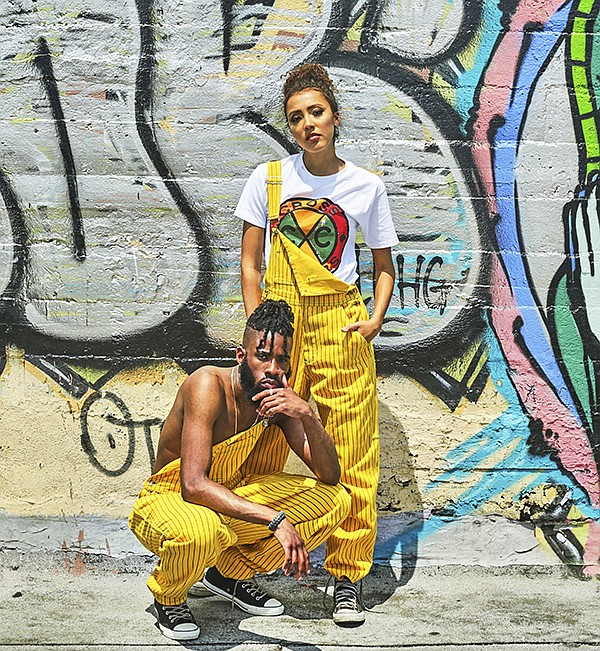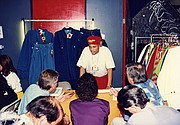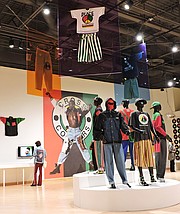CROSS COLOURS AT 30
Intent on Empowering a Community, Cross Colours Crosses Over Into Iconic Status
Starting 30 years ago with an apparel-manufacturing idea that would reflect the culture of an often-underrepresented community, TJ Walker and Carl Jones launched Cross Colours, the Los Angeles–based brand that relied on colorful fabrics and designs inspired by young people. Working together at the Surf Fetish brand, Walker, the graphic artist, and Jones, the owner, formed the Cross Colours partnership. While the duo sought to build a brand with which young black youth could identify, they succeeded in creating a legacy that reached far beyond boundaries.
“When we started, we made a valiant effort to address an industry that was underserved,” Walker explained. “As black people, we felt we had the purchasing power. We bought clothes and accessories, but in the market we were never identified as the consumer of the product in the advertisement or of the product itself in terms of design, patterns and production.”
The brand hired black models such as a young Djimon Hounsou and invested in featuring apparel made to recognize the demands of consumers in the community. There was one particular moment during the early 1990s that launched the company onto a path that would place it among the icons of apparel.
“Our marketing director, David Stennet, took overruns of product to a studio to see if the stylist would be interested in putting them on entertainers on a show. The show happened to be ‘The Fresh Prince of Bel-Air.’ Because they loved the product, they got it on Will Smith within a day,” Walker said. “That is how we started marketing and product placement.”
This formula worked, with the brand growing to unveil advertising campaigns that featured Dr. Dre, Snoop Dogg and Earvin “Magic” Johnson. A strong celebrity following included notable names such as Tupac Shakur, TLC and Jamie Foxx.
Feels like MAGIC
While boasting a celebrity clientele is impressive, Cross Colours also quickly gained recognition among industry insiders. During their first Las Vegas MAGIC industry trade show in February 1990, Walker and Jones wrote approximately $10 million worth of orders.
“We had exhausted all of our funds to get there, doing the samples, preparing for it, and we made a custom booth. There wasn’t much color present in the industry in terms of fabric and in terms of people as well,” Walker explained. “We broke barriers in quite a few areas just coming to the show. When we got there, we found that people liked what we had.”
Walker and Jones’s message of peace and unity, meant to quell gang violence and empower young kids within their community, still resonates today.
“When we talked about inclusion and diversity, those were issues we dealt with in the ’90s, but now they’ve been given a different word,” Walker said. “Even the clothing has evolved. First it was called ethnic, then it was urban, and now it’s called street.”
Through Cross Colours, Walker and Jones continued to create clothing throughout the early 1990s, speaking to their target audience comprising young people of color, yet the brand enjoyed mainstream success. Unfortunately, financial problems experienced by Cross Colours’ largest retail partners adversely affected the brand, which suspended operations in the mid-1990s.
Redeveloping the business
Available online at www.crosscolours.com and retailers such as Lynnwood, Wash.-headquartered Zumiez, Cross Colours is manufactured in men’s sizes S-2X or 3X—depending on the style—and women’s XS-L. Retail pricing for basics ranges from $38 to $78 and $298 to $2,100 jackets.
While the brand manufactures basic styles overseas in Asia and Mexico, these products are finished in Los Angeles. Its denim and leather jackets, designed in retro styles, are created in Los Angeles, affording a special connection to the brand’s home.
The mission of connecting with the community through positive messaging has not changed for Cross Colours, but Walker noted that there are changes within the market through which the brand must navigate.
“The industry has changed totally since then and that is a huge learning curve for us as well,” he said. “We have social media now—Instagram, Facebook, Twitter and other platforms to use for marketing promotion and sales. That is a full-time job and created new positions that were not there years back. There are new positions that have been created but others that are gone.”
In addition to developing the business to suit today’s market, Walker recognized how young people consume information. This shift has transformed the ways in which his audience shops, creating a need for Cross Colours to adapt to the immediacy of consumer demand.
“What has really changed is the youth, who are the customers we are trying to engage. It’s all about keeping the youth engaged. Because of the internet, how quickly things move and how much content is available to them within minutes, the news is so readily available,” he said. “Mobile devices are your sales tool for retailers and wholesalers. Those things are important.”
Crossing back onto the scene
According to Walker, the brand has been back for four years. Many would argue that Cross Colours never went away, it simply entered a hiatus period. In addition to its popular tagline, “Clothing Without Prejudice,” the positive role the brand played extended into outreach through providing haircuts to children, supplying toiletries to those in need and organizing food drives.
From the appearance of Cross Colours–outfitted Cardi B and Bruno Mars performing together at the 2018 Grammy Awards to a new exhibition, “Cross Colours: Black Fashion in the 20th Century,” at the California African American Museum in Los Angeles, the brand’s legacy is now being celebrated.
“We are drawing direct parallels of the brand’s DNA to social movements throughout the last century that speak to a certain political ethos the brand has always intertwined,” said Tyree A. Boyd-Pates, the museum’s curator of history. “It adds to the conversation of black innovation within fashion. It can also add to drawing important parallels to how black fashion is political and has always been.”
Organizing the exhibition to showcase Cross Colours pieces, archival materials and imagery, Boyd-Pates and Assistant History Curator Taylor Bythewood-Porter complemented the apparel with stories and images from important moments during the struggle for African-American equity. Across from a television screen displaying footage of “The Fresh Prince of Bel-Air” and Cross Colours apparel, stories of Marcus Garvey, Malcolm X, The Black Panthers and 1960s-era civil rights activists are told, many of which provided inspiration for details on the garments.
“Black fashion is political as much as it is trendy. Cyclically, with this popular brand from the 1990s, one could forecast its popularity again 30 years later,” Boyd-Pates said. “Much like the sociopolitical climate of the 1990s, there isn’t much of a departure from that today. Brands like Cross Colours will always remain in vogue because they speak truth to power when power could be abused.”
Building upon a legacy
Visiting the California African American Museum from New York, Andreya D. Matthew took her time to fully experience the Cross Colours exhibition. She realized how familiar she was with this impactful brand whose name she never knew. Growing up as a child in the 1990s as Cross Colours’ successors such as FUBU launched, Matthew was familiar with the colorful apparel worn by actors on programs such as “Martin” and “In Living Color.”
“I never knew the name of the brand or where it came from, but now I remember it and wanted to get something like that,” she explained. “It was in our culture so much that I can’t imagine our culture without it. I am glad they are doing this exhibition, letting everyone know.”
Moving into the future of Cross Colours, Walker reflects on how the brand has reentered the apparel space, attributing its success to the legacy he and Jones created.
“Make sure it will be something that is going to give back. Don’t just take with whatever you create, you have to have a giveback component to it,” Walker said. “In that way, you’re always going to have it in a position where it can come back to you and where it can always be something that people want to give back to you as well.”
























